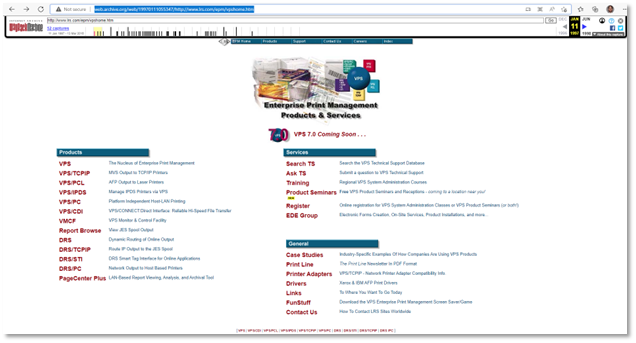Earlier in the week, a colleague asked me a question about an extension product we used to sell in the early days of local area networks. I couldn’t find much information in my files, so I fell back on one of my favorite Web resources: the Internet Archive, also known as the Wayback Machine.

After getting the information my colleague needed, I spent a nostalgic hour or two looking through customer case studies and reading newsletters from a quarter-century ago. The Wayback Machine even let me click through progressively newer generations of the website to see how things changed over time. This brief stroll down Memory Lane drove home a few messages:
Technology changes incredibly quickly. Business needs don't.
The very first customer I interviewed for a case study in 1995 was a hospital focused on cost reduction, increasing automation using barcode labels, and improving print in affiliate branches. A quarter-century later, healthcare organizations still face these same challenges. Their applications may run in the Cloud instead of an IBM mainframe, but the business needs are essentially unchanged.
Printers, fax servers, and other output devices can be very problematic.
Early versions of our website included links where customers could obtain the latest drivers for popular printers and check compatibility with various network devices. Today, universal drivers and widespread use of XML have addressed some of these issues. However, many printers and MFPs now include on-board storage and web capabilities, making them a tempting target for malware attacks. There will always be a need for secure, scalable and robust software to manage these output devices.
Customers consider LRS a partner, not just a vendor.
In both user case studies and stories in our customer newsletter, one theme is clear: large enterprises count on the expertise of LRS’s technical staff as well as our willingness to work with customers to address their document challenges. This is true even when the problems are caused by a faulty network configuration, a hardware problem, or other issue outside LRS’s control. In fact, some of our oldest technology alliances originated with our collaboration to address a specific challenge at a mutual customer.
The "any document, from any platform or application, to any destination" strategy has stood the test of time.
While many of the customers listed on our website back in the late 1990s are still LRS customers today, their IT environments are less likely to feature mainframes and SNA networks and more likely be running in the Cloud. Out with fax servers and mainframe terminals, in with workgroup multifunction devices and virtual desktops. As these environments changed, LRS software evolved to support these changes. As such, investments in LRS software made decades ago are still paying dividends today.
I have no intention of being in the workforce 25 years from now. However, something tells me that while much will surely change, the bond between LRS and our customers will be every bit as strong. And if I’m lucky, a copy of this Blog story will still be available on the Wayback Machine.